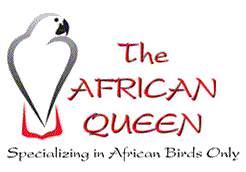Cape Name Confusion
Jean Pattison, 2006
Reclassification of the Cape Parrot
As with reclassifying any species or subspecies there is usually much confusion early on. So it is with the Cape Parrot. In the May issue of Bird Talk, there was a letter to the editor regarding the scientific names of the Cape parrot. The nominate species name was just reversed. I hope to clarify this.
As some of you may have read, the Cape parrot (Poicephalus robustus) has been reclassified. The South African Cape parrot will now be the only "true" Cape parrot, being a species by itself. What we knew as the other two Cape parrots, P. r. fuscicollis and P. r. suahelicus, will now be known as the Brown-necked parrot, P. fuscicollis fuscicollis, and the Grey-headed parrot, P. fuscicollis suahelicus, respectively. To say the least, this will be most confusing since there is already a species called the Brown-headed parrot, P. c. cryptoxanthus, in this genus.
If one has internet access, there is a very good web-site about Cape Parrots, http://www.capeparrot.org.
Going back to basic biology one needs to understand a type of trickle down effect. Life starts at the top and can be divided into "types," animals and plants. Each of these are split into "types." In the animal world we find mammals, insects, birds, fish etc. Each of these is split into "types." Bird "types" are split into flightless birds, water birds, perching birds, birds of prey and parrots, as well as some others. Parrots are further split into "types" known as Genus. A Genus is a group exhibiting very similar characteristics. The Genus is broken down further into "types" known as species. A species is a more finely tuned group whose members share the same general characteristics. As if that isn’t enough, the species are broken down into more "types" known as subspecies.
Some of the guidelines for defining a subspecies are bone structure, size, shape and color difference, habitat needs, and physical separation such as mountain ranges, canyons, deserts, or large expanses of unpopulated areas. Unfortunately there are many gray areas when defining a subspecies, and much depends on the group of scientists involved. In the reclassification of the Cape parrots, DNA was also used to establish the differences in the species.
The Brown-necked parrot (Poicephalus fuscicollis fuscicollis) belongs to the Genus Poicephalus. The genus is always capitalized so you know you are dealing with a genus. The species is fuscicollis, which follows the genus name and always starts with a lower case letter, thus one knows it is a species in that genus. When the Genus name is followed by duplicate species names, example being Poicephalus fuscicollis fuscicollis, one knows there are more than one species, which will constitute dealing with subspecies. One also will know, that the duplicate name is the nominate subspecies of that species, being the first one discovered. Once the genus and species has been established in published articles, the full spelling may be dropped and the Genus and species names may be referred to by the first letter of each, respectively.
Resources: Prof. Mike Perrin from the University of Natal, personal communications as well as Proceedings of the American Federation of Aviculture (AFA), 2001 Convention, pages 20-24.


